Here are some ideas, sorted by relative preference, for a visit of Arezzo, which can be seen over a whole day, or better yet over a weekend.
The historic centre preserves beautiful monuments, churches, palaces and museums.
See also at the end of page Touristic map of ArezzoAnd read the presentation page of
Arezzo
Piazza Grande in Arezzo
The Piazza Grande is the most striking square in Arezzo, the heart of the city since the Middle Ages and has the particularity to be trapezoidal and sloping!
Beautiful buildings surround it: the Faggiolana Towers, the Lappoli Palace, the Cofani Brizzolari Palace and the Lappoli Tower House on one side; on the other side the splendid porticoes of the elegant Palazzo delle Loggia by Giorgio Vasari (late 16th century) and the Carrousel del Sarrasin. The Palazzo delle Logge was originally the customs offices, today a musical high school and the Vasariano Theatre.
On the western side is the church of Santa Maria delle Pieve, the Fraternity Palace with the astronomical clock, and the pretty public fountain.
It is a good place to relax, with some cafes and restaurants.
In the cinema, we could see this place in Life Is Beautiful by Benigni. This is where the Monthly Antique Fair is held, and twice a year the traditional festival of the Saracen Joust (Giostra del Saracino in Italian).
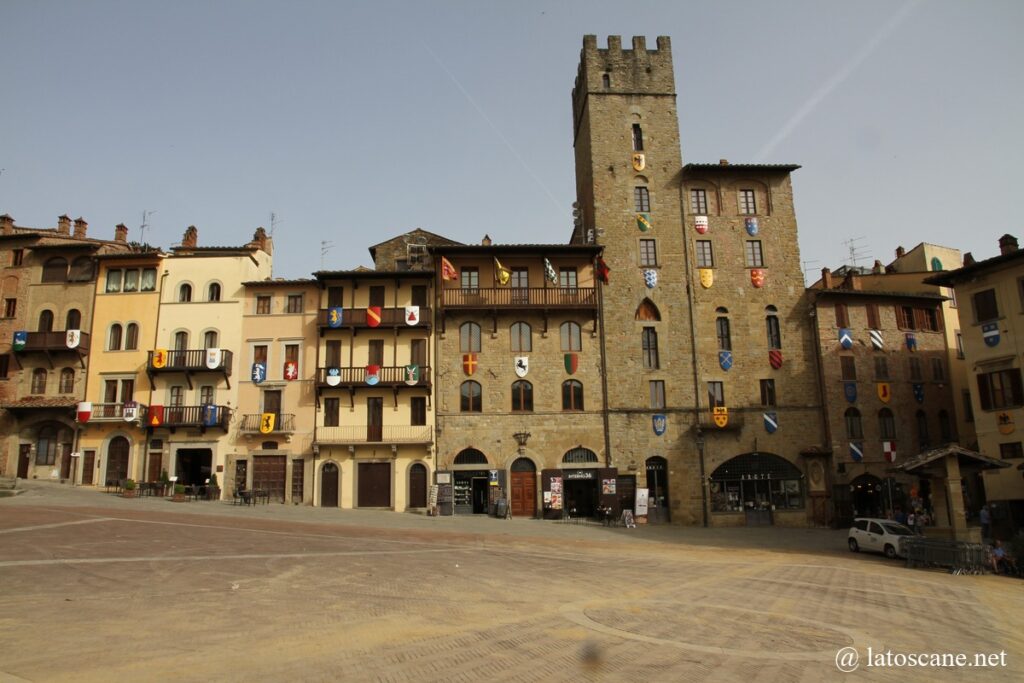
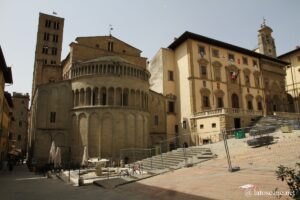
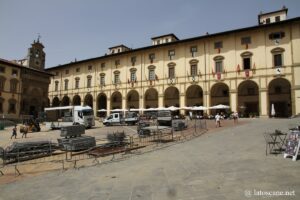
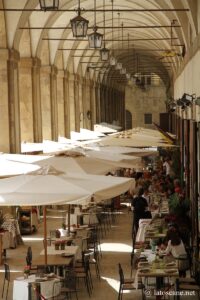
Basilica of St. Francis in Arezzo
The Basilica of St. Francis of Arezzo (in Italian: Basilica di San Francesco) dates back to the 13th century, a Franciscan-inspired Gothic building famous for its frescoes by The Legend of the True Cross by Piero della Francesca. The external ornaments are meager as usual in the Franciscans, apart from the arched windows and the rosette.
The cycle of frescoes commissioned by the Bacci family decorates the interior, and was started by Bicci di Lorenzo before being continued by della Francesca, with the theme of the wood on which Christ was crucified. The result is impressive for its strength and elegance of figures. This work, completed in 1466, remained unsurpassed until the achievements of Raphael and Michelangelo in the Vatican.
Its 15 scenes are inspired by the text of the Golden Legend written by Jacques de Voragine, very famous in the Middle Ages. These memorable images evoke the death of Adam, the Dream of Constantine, etc.
The great crucifix on the altar is attributed to Duccio di Boninsegna and would be from 1289.
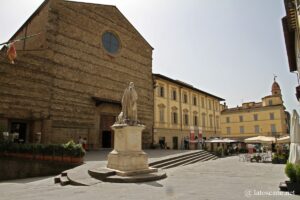
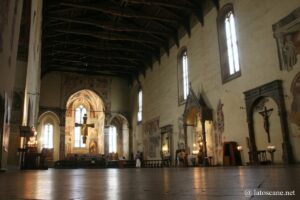
Cathedral of Arezzo
On the site of the ancient acropolis at the top of the city, the majestic Cathedral of Saints Donat and Peter of Arezzo is preceded by the statue of Ferdinand I of Francavilla of Giambologna.
It was built between 1278 and 1511, with Gothic stained glass windows by Guillaume de Marcillat early 16th century that represent episodes of the Gospels. This master French glassmaker also painted the vault.
The Chapel of the Virgin of Consolation welcomes a Mary, patron saint of the city, in terracotta and considered miraculous.
It preserves among other things a fresco of Mary Magdalene by Piero della Francesca from about 1460, the wooden choir designed in 1554 by Giorgio Vasari, the Holy Trinity between saints Donato and Bernardo by Andrea della Robbia, etc.
The facade was redone in the early 20th century.
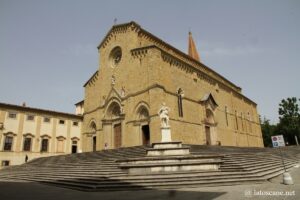
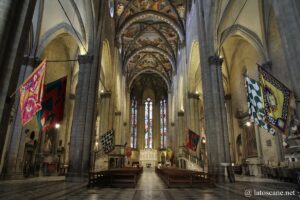
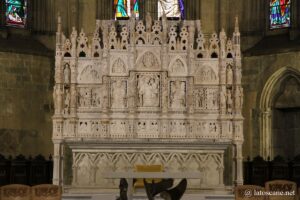
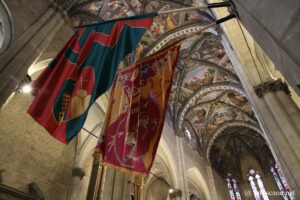
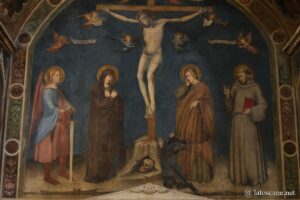
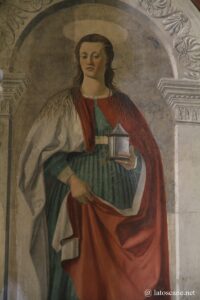
Passeggio del Prato and the Medici Fortress
The ancient acropolis of Arezzo is now occupied by the Passeggio del Prato, a green space for relaxation, located on the heights with beautiful views over the region.
There are also the remains of the Medi Fortress (in Italian: Fortezza Medicea) built by order of Cosmes I de’ Medici by Antonio da Sangallo il Giovane between 1538 and 1560, with its pentagonal shape. The walls and crypt of a medieval church remain. Much of it was dismantled in the 19th century.
Basilica of San Domenico in Arezzo
The exterior of San Domenico d’Arezzo is in the Romanesque-Gothic style with an unfinished façade.
The church preserves in particular a large Crucifix of Cimabue (from his real name Cenni di Pepo, who was master of Giotto), more than 3 meters, which is said to have been painted around 1270.
His idealized figures mark the transition from the Byzantine tradition to living subjects, expressing emotions and humanity.
Many frescoes have largely disappeared, except for the one with the gothic altar of the Dragondelli Chapel. The funeral monument of Ranieri degli Ubertini in Gano di Fazio is the oldest example of a hanging tomb in Arezzo.
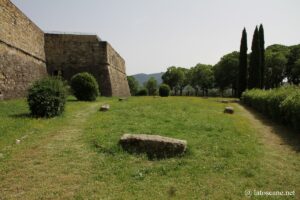
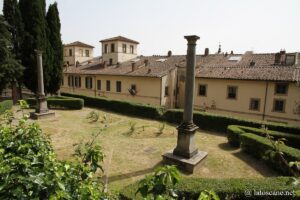
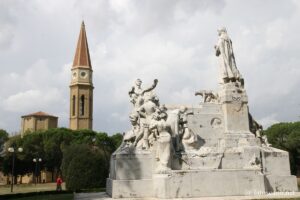
Church of Santa Maria della Pieve
The remarkable church of Santa Maria della Pieve in Arezzo has a remarkable Romanesque apse on its Piazza Grande. Its façade is located on Corso Italia.
Its origin is probably before the eleventh century. It is now a Romanesque and Gothic building with an original facade decorated with blind arcades and three levels of loggias. The thick tower has nearly a hundred mullioned windows.
The austere interior is impressive. It preserves the polyptych of the Virgin and Child with the Annunciation, the Assumption and the saints by Pietro Lorenzetti. The baptismal basin is by Giovanni d’Agostino.
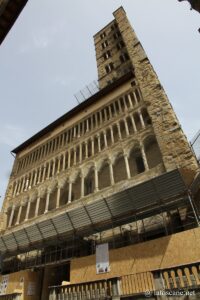
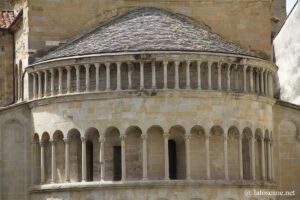
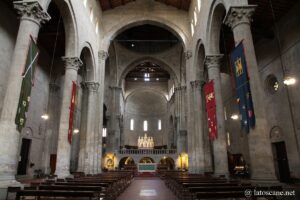
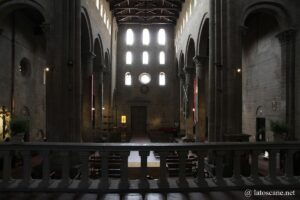
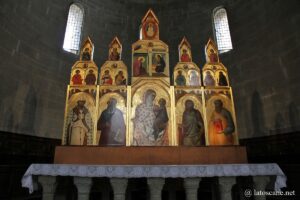
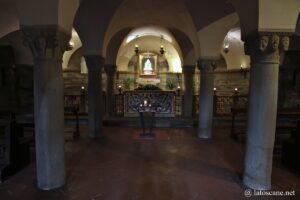
Santa Maria delle Grazie
Santa Maria delle Grazie is located just outside the walls of Arezzo. It was built on the site of an ancient temple dedicated to Apollo, near a spring that was demolished by San Bernardino in 1428.
He then built an oratory where Parri di Spinello painted the fresco with the image of the Virgin of Mercy (1431). This one is framed by the marble altar of Andrea Della Robbia with in the tympani the Saints Lorentino, Pergentino, Donato and Bernardino.
The portico painted with a starry sky was built in 1490 by Benedetto da Maiano, who took inspiration from the Hospital of the Innocents of Brunelleschi in Florence.
Museum of Medieval and Modern Art
Housed in the Palazzo Bruni-Ciocchi (or Palazzo della Dogana), one of the most beautiful Renaissance buildings in the city built in the 15th century, the Museo d’Arte Medievale e Moderna d’Arezzo is very interesting.
Its rooms, arranged by chronology, house works from the 13th to 16th centuries by masters such as Lorenzetti, della Robbia, di Spinello, Vasari, ceramics and 19th century works.
Casa Vasari
The house-museum of Giorgio Vasari is dedicated to the illustrious artist born in Arezzo in 1511, who decorated with frescoes with biblical and mythological themes, painted by himself and his students. However, he lived more in Florence and Rome.
She keeps paintings of himself and other Tuscan artists, mainly mannerist.
It is an interesting and rare example of a Renaissance artist’s house, with a garden and the apartment with frescoed rooms.
Diocesan Museum of Arezzo
In the Palazzo del Museo Diocesano in Piazza Duomo are preserved works of art, including three remarkable wooden crucifixes, works by the Tuscan painter Bartolomeo della Gatta and works by Giorgio Vasari.
National Archaeological Museum Mecenate
The National Archaeological Museum Gaio Cilnio Mecenate is housed in the former monastery of San Bernardo, itself built on the remains of the Roman amphitheatre from the middle of the 2nd century AD. Its vaults can be seen on the ground floor. Gaius Maecenas was a character of the time of Augustus, native of Arezzo and well-known protector of artists.
The collection extends from prehistoric times to the Roman period, including the important Etruscan period, especially the famous ceramics of Arezzo.
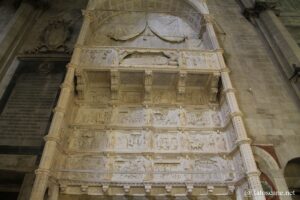
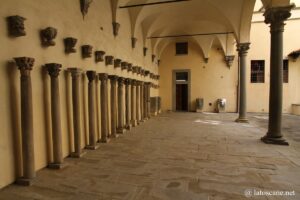
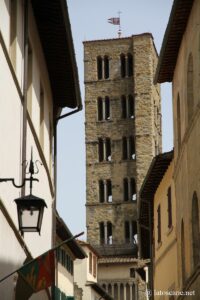
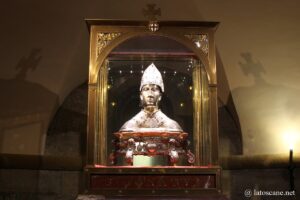
Other churches
Badia delle Sante Flora e Lucilla
The Badia delle Sante Flora e Lucilla was the main Benedictine monastery of Arezzo, built from the 13th to 16th centuries, with a Renaissance cloister.
The first church of the early 13th century was enlarged and its style marked the transition from Romanesque to Gothic. It was modified in particular in the 16th century on a project by Giorgio Vasari, which also preserves works of the latter.
Among the fine works that embellish it is a Renaissance masterpiece with the Saint Lawrence (San Lorenzo in Italian) painted by Bartolomeo della Gatta in 1476. In the 16th century, Vasari and his students are the authors of the high altar with his paintings. Above the transept is the famous false dome by Andrea Pozzo from 1702. The Great Crucifix by Segna di Bonaventura dates to 1319.
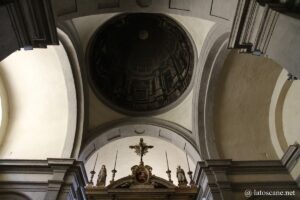
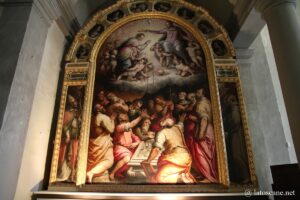
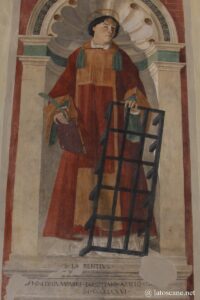
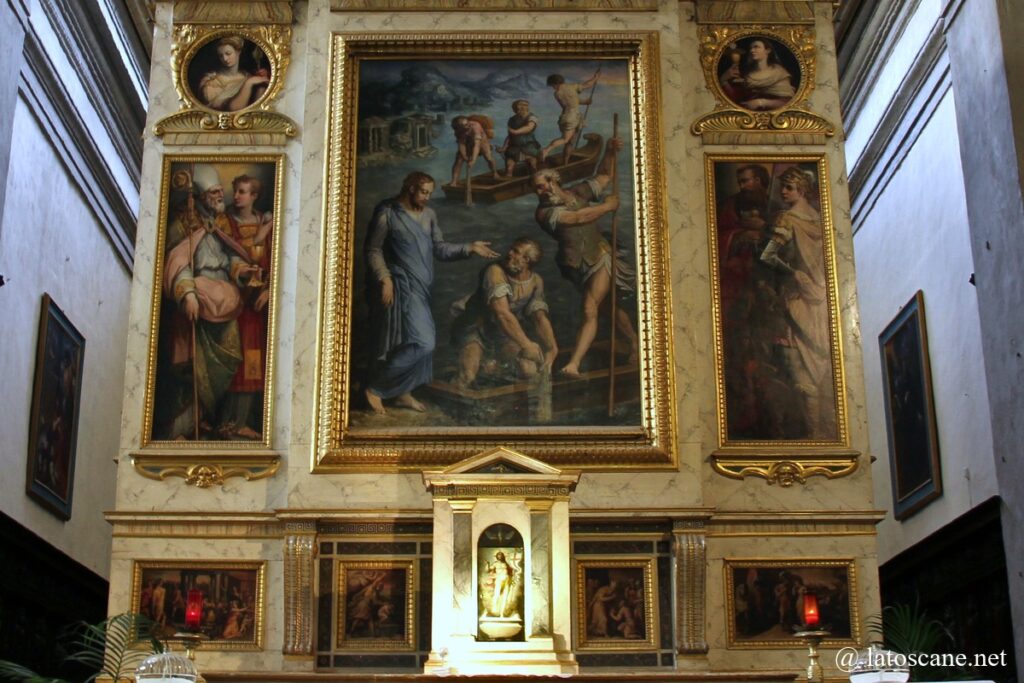
Santissima Annunziata of Arezzo
The Church of the Santissima Annunziata in Arezzo is an important Renaissance church, dating back to the birth of the Santa Annunziata Company created by a group of nobles from the city in the early fourteenth century who built it as an oratory. The latter was later incorporated into the façade. At the end of the 15th century, Bartolomeo della Gatta was the author of the new church.
On the right side of the church is a masterpiece from the 14th century in the large tabernacle, the Annunciation dated about 1370, with inside a youth work by Giorgio Vasari, the Deposition of Christ from the 16th century, on the altar a painting by Pietro Castellucci in 1676 depicting seven saints, with a bust of the Madonna with Child from the early 16th century. There is also a magnificent wooden crucifix from the 14th century, the 16th-century polychrome marble high altar that hosts the miraculous Our Lady of Tears (15th century).
Palace
Praetorian Palace of Arezzo
Since 1290, the Palazzo Albergotti has been the seat of the captain of justice and for centuries it has hosted several magistracies.
Built between the 14th and 15th centuries, the Palazzo Pretorio is characterised by its façade covered with the coat of arms of the Podestà, captains and commissioners who governed the city. Today it houses the Arezzo public library.
Palazzo dei Priori of Arezzo
The Palazzo dei Priori of Arezzo still used today as the seat of the Commune dates back to the first half of the 14th century and has been, since the Middle Ages, the place intended to accommodate the highest magistracy in the city. Inside, you can see many works of art, including frescoes, statues and architectural elements.
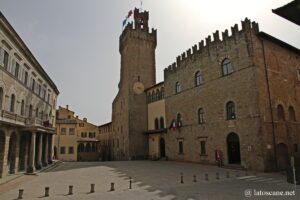
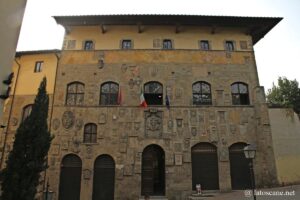
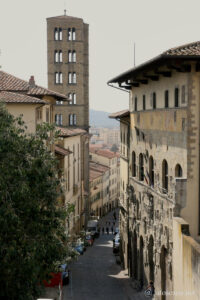
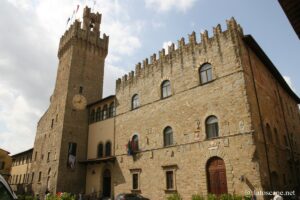
Petrarch Academy
Francesco Petrarca was a great scholar of the fourteenth century, born in Arezzo, poet and one of the fathers of humanism. The Petrarch Academy has its library and unique objects related to the poet, in a palace built opposite his birthplace in the 16th century.
Touristic map of Arezzo
If you see this after your page is loaded completely, leafletJS files are missing.
Links and sources
- Museums of Arezzo including San Francesco: museiarezzo.it
- Tourist portals: www.discoverarezzo.com, www.visitarezzo.com, www.visittuscany.com
- Arezzo Cathedral: www.duomoarezzo.it
- General information: en.wikipedia.org
Articles about Arezzo
- Arezzo in Tuscany
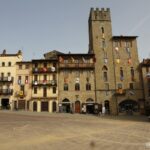 Arezzo is a beautiful discovery of Tuscany, less visited than other cities in the region despite a particular and unexpected charm. It is located in the east, close to Umbria ...
Arezzo is a beautiful discovery of Tuscany, less visited than other cities in the region despite a particular and unexpected charm. It is located in the east, close to Umbria ... - Hotels and accommodations in Arezzo
 Book now accommodation in Arezzo or Tuscany, hotel, room or apartment, among nearly 150 structures
Book now accommodation in Arezzo or Tuscany, hotel, room or apartment, among nearly 150 structures - Visits and tours in Arezzo
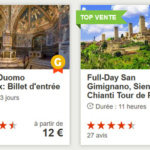 Proposals for guided tours and other activities in Arezzo and its surroundings, entrance tickets to monuments, etc
Proposals for guided tours and other activities in Arezzo and its surroundings, entrance tickets to monuments, etc - Weather forecast in Arezzo
 Weather forecast in Arezzo in Tuscany today and the next days, precipitation, temperatures, weather next week, etc Weather forecast 5 days in Arezzo Detailled weather forescast in Arezzo Into the same category
Weather forecast in Arezzo in Tuscany today and the next days, precipitation, temperatures, weather next week, etc Weather forecast 5 days in Arezzo Detailled weather forescast in Arezzo Into the same category


No Comments Yet